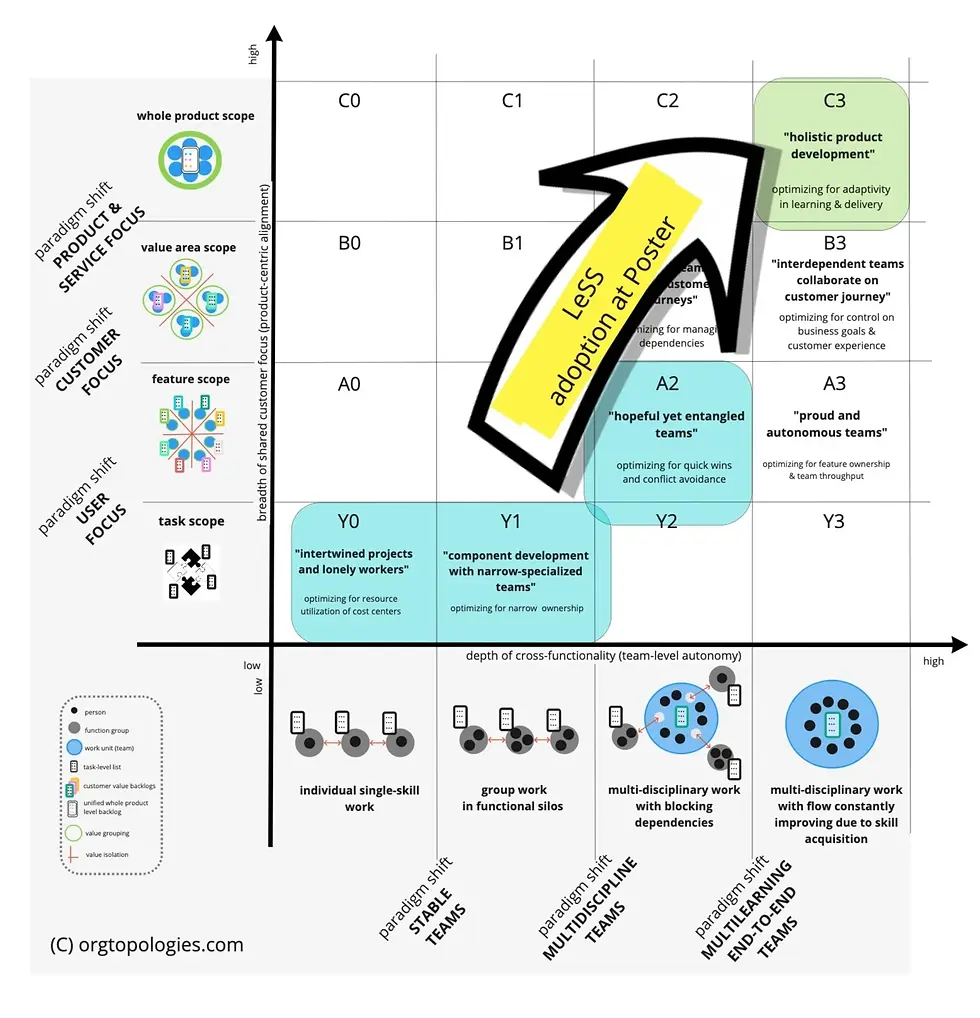Recently, we recorded an episode for Zuzi Sochova's podcast. I can tell, this was the most precise and crispiest explanation of #OrgTopologies that we've done up to now. One particular aspect of the podcast that I'd like to elaborate here is what I humorously called a 'Human Framework Dependency Syndrome', or HFDS. So, what is that?

Frameworks are not the Problem
Let me start from the beginning. #OrgTopologies is a visual thinking and mapping tool that helps describe, analyze, discuss and improve org designs. It is a great helper for leaders and change agents in planning and executing more sustainable and deeper org changes.
#OrgTopologies is not a framework. But rather a field (or simply a 'schema' as per Dave Snowden's suggestion) on which other frameworks and org design ideas can be mapped, and then compared and contrasted.
It is important to stress this: we at #OrgTopologies are not against frameworks. In fact, we believe they can be quite useful, provided some other conditions are true. Let's see.
'Framework Thinking' is the Problem
We are up against, what we call, frameworks thinking -- being dependent upon a framework and hoping that it will solve all the issues at hand. This especially becomes true when an organization hires an expensive consultancy firm that comes with a slide deck that recommends a specific framework. It is when the 'Framework Dependency Syndrome' hits hard.
We say this at every conference talk that we do:
"Implementing a framework cannot be the goal of an org transformation."
The goal of an org change is to create a different (better) organization that produces different (better) results. And frameworks (as well as other org design ideas) can be helpful tools on the journey. But they are just the means to an end.
Unique Journey
What is an 'org change'? It is a unique challenge that is specific to a given organization. It is a risky journey out to the unknown with a hope of arriving at a better state of affairs. There is no book on how to improve your organization (unless you write one after the journey is done). And there are no consultants on this planet who have done exactly the same transformation (unless you become one afterward).
We are not against any frameworks, consultants or good solutions. But what happens when an organization doesn't own its transformation? The research results are clear:
"I know what I wouldn’t have done, and that is outsourcing the problem to McKinsey… and have them find a solution. The research results are clear. The solutions must come from within the organization." – John Kotter
To put it in order words: to be successful at a change is to own it. And what does it take to own a journey? It is to know 1) the gains of the journey, 2) the starting point, 3) the desired end state and, hence, 4) the direction. Plus having 5) an idea on what it takes to get there and then make 6) a conscious strategical decision to embark on the journey.
These are the six minimal ingredients of preparing for an org change.
Is it all it takes? Of course not. The reality of the change will be different from the plans. So, continuous adjustments are vital for course correcting and staying on track towards the desired end-state.
Thus, having freedom to change the approach (framework) when it doesn't yield the expected results is essential for a successful change. And on the contrary, being dependent upon a fixed approach (framework) is a good recipe for failure.
Own the Change
That's where #OrgTopologies become handy by helping you visualize, analyze and keep discussing the change journey: from an A to a B, from one particular org state to the other, with not so much focus on a chosen framework but on the journey itself and the goal.
Below is an illustration of one of such journeys done by a Ukrainian-based company Poster in 2021, going from Y1 to C3 -- as per the map below:
Poster chose LeSS (Large-Scale Scrum) as an inspiration and a framework, but was not locked by it. The desired target state of "being able to work with all the teams on anything that is important for the business" (also known as a system optimizing goal towards high organizational adaptability) was much more important than following some prescribed ideas or dogmas.
So stay sane, stay healthy and own your change.






Comments